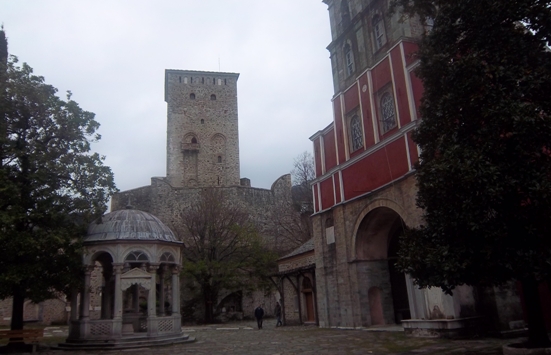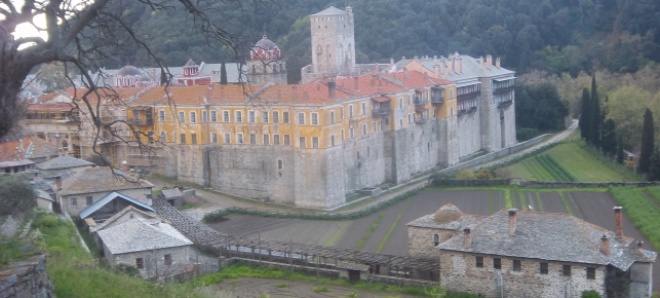
Website: imiviron.gr / Email office: imiviron@gmail.com / Email hospitality: ivironfiloxenia@gmail.com
Iviron monastery ranks third in the hierarchy of the Athonite monasteries, it is coenobitic since 1990 and celebrates on the Dormition of the Theotokos Iviron is located on the northeastern side of Athos peninsula on a small cove, next to the estuary of a big torrent.
It was founded in the 8th century as Clement’s monastery. In 980, John Tornike, a monk and prominent member of the royal court of Georgia, which was then known as Iberia or Iviria, came to monastery. Together with a group of “Iberian” monks of Great Lavra, they extended and transformed it in a Lavra, i.e. a big monastery.
After 1010 the monastery acquired its present name in honor of its re-founders. During the 10th and 11th centuries, many small monasteries, such as Kolovou, Prophet Elijah’s, Sisikou, etc., became dependent on Iviron. In 1259, it was destroyed several times by pirates, mostly Franks. In the early 15th century, Iviron suffered a complete financial collapse. Soon, it clawed back and in the end of the century it got many more Greek monks and thus became a Greek monastery.
Then, with the support of Georgian and Romanian princes as well as the Ecumenical Patriarchs, it came to its hayday during the 18th century. In 1865, it was almost fully incinerated, but soon it was renovated. Iviron greatly contributed to the Greek war of independence in 1820s and it was here, where the Ethnomartyr Gregory V of Constantinople cloistered, when he was in exile.
The monastery compound is big and impressive. The entrance to the monastery is on the north. The Catholicon lies on the eastern part of the yard, straight across from which is the bell tower and the dining hall. The buildings on the yard are surrounded by the wings, which form a quadrangle, where lie the cells of the monks, the administration offices, the tower, the guesthouse and the library.
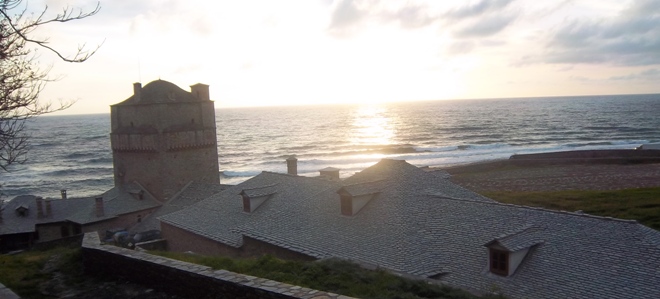
The monastery lies in a distance of 75 minutes from Karyes and 60 minutes from Stavronikita monastery walking on a gorgeous trail, when weather conditions permit. From Philotheou monastery it’s an hour, half on a forest road and half on a beautiful trail, and from Karakallou it is 90 minutes on a beautiful forest road.
Next to the old entrance, there is located the chapel of Theotokos Portaitissa (the Gatekeeper) with the miraculous homonymous icon of the Theotokos. The icon is carried to the Catholicon only on the great feasts and it is taken in procession on Renewal Tuesday. The frescoes of the narthex date back to 1774 and depict wise men and kings of antiquity. Moreover, just a step away from the monastery, by the sea, lies the Seat and Holy Water of Theotokos Portaitissa, where her icon was found.
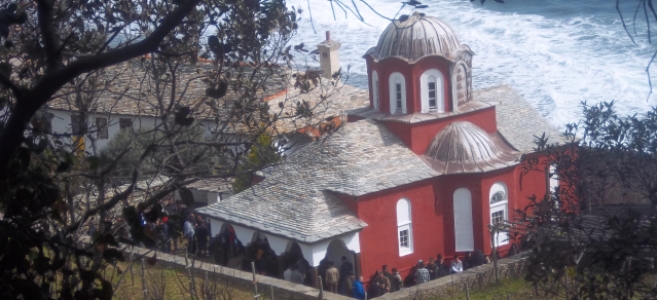
Theotokos Portaitissa, the guardian of Mount Athos
During the Byzantine Iconoclasm (8th-9th century AD), many icons were thrown into the sea to be saved from the iconoclasts. God’s providence led them to places, where they were protected and revered. So, a pious woman in Nicaea decided to throw her icon of Theotokos Portaitissa into the sea; she grieved and mourned for the loss of her beloved icon, but the Most Holy Theotokos gave comfort to her during her sleep and told her that she will send the icon to a place, where many nations and languages will worship it for centuries.
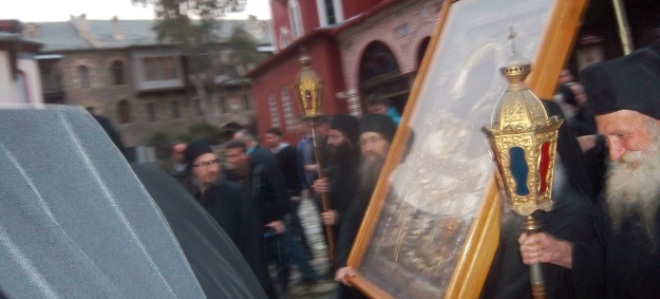
Many years later, in 1004, the icon appeared over the sea opposite to Iviron monastery, floating upright over the water. The monks marveled and tried to bring the icon out of the sea but an invisible power prevented it.
A short distance away from the monastery, in the hills lived an anchorite named Gabriel. Theotokos appeared to him and told him: “I want you to come and bring my icon out of the sea, because it is you that I find rightful to carry it to the monastery”. The anchorite complied and descended to take the icon. But when he got into the sea, to everybody’s surprise, he did not sink but walked on the waters, until he brought out the icon to the sand. In the place, where the icon first stood after coming out of the sea, holy water spurted, which streams to this day.
Anchorite Gabriel together with the abbot and monks transferred the icon to the Catholicon and set it up in a prominent place. But the next day they did not found it into the church but over the gate. This was repeated several times and the monks figured out that Theotokos wanted to stay close to the gate. Moreover, she appeared to the abbot and told him: “I came here to guard you, not to be guarded”. After that, they built a beautiful chapel next to the gate and the icon was put there, where it stands up to the moment as a guard, doctor and protector of every monk on Mount Athos. Thus the name of the icon “Gatekeeper”.
An Athonite tradition says that, if the icon of Portaitissa leave Mount Athos, the monks must also leave. According to St. Nilos the Athonite Myrrh-gusher, when lawlessness multiplies, the icon will depart from Mount Athos.
There is an obvious scar in the Most Holy Theotokos’s jaw. A savage pirate strabbed the holy icon on here and blood ran. But then, the barbarian repented and became a monk and a faithful servant of the Theotokos in this monastery. Moreover, rather that the new name he was give, he liked better the name Barbaros (i.e. barbarian). This monk reached heights of virtue and nowadays the Orthodox Church commemorates St. Barbaros the Ivirete on May 13th.
In 1651, 365 Ivirete monks were facing financial hardships; hence, they entrusted the Theotokos to see to their subsistence. Soon after, the affectionate Mother hustled for their livelihood, doing the following wonder. Back then, the daughter of the Russian czar Aleksey Mikhailovich Romanov was seriously ill. But her and her royal parents’ grief was turned to joy by miraculous Portaitissa. The paralyzed maiden recovered and the czar expressing his gratitude ceded one of the greatest monasteries of the russian capital, St. Nicholas’s, to Iviron.
This succursal remained in Iviron’s freehold until 1932, bringing in so many revenues, that it almost catered for all its material needs. This is why the Russians are so greatly and obviously connected with Theotokos Portaitissa to this day.
